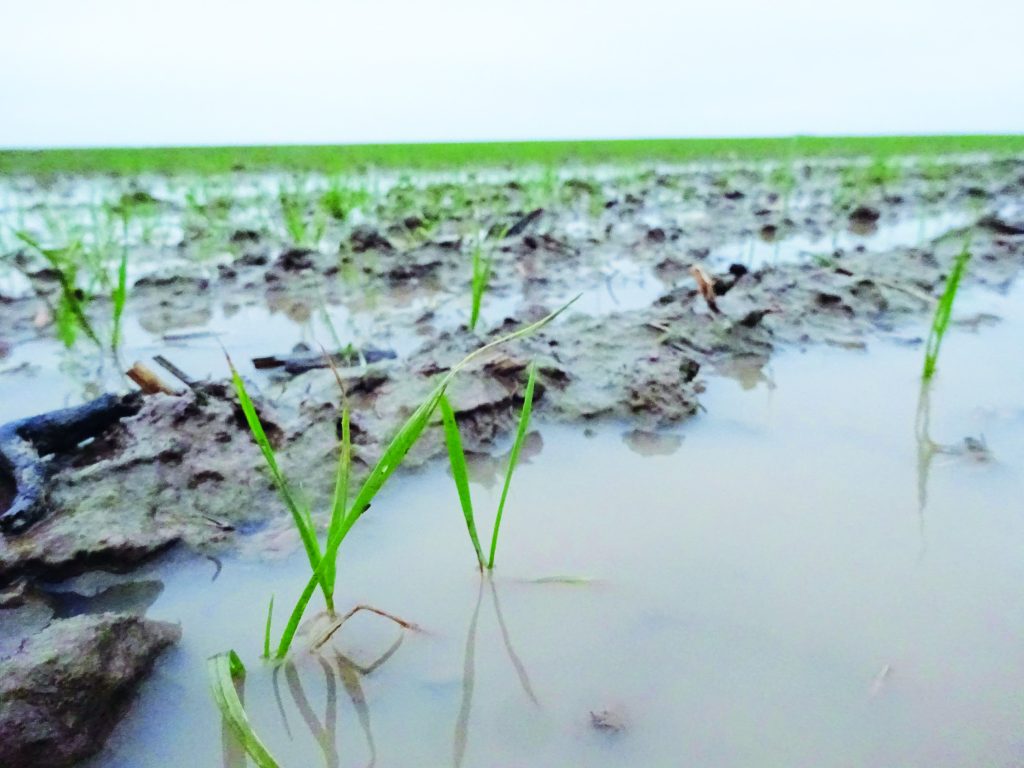With relentless winter rain in many parts of the country following an already challenging autumn for many, winter-sown crops are going to need a lot of care and attention in the next few weeks to get them performing to their full potential in 2024. Agrii’s R&D fertiliser technical manager Jim Carswell takes a look at what insights the company’s latest trials are providing to help growers kickstart backward crops this spring.
It’s been a tough winter for autumn-sown crops. For a start, many were drilled into less than optimal soil conditions, much later in the season than is ideal for strong pre-winter establishment, with higher than average rainfall in many parts of the country since, only making an already difficult start to the growing season significantly worse.
Many growers that managed to avoid flooded fields in January, still face the prospect of thin, backward crops with poorly developed root systems, sitting in saturated soils and vulnerable to pests and diseases.
Tiller numbers are likely to be lower than usual and where slug damage has occurred green area index (GAI) will be reduced. Such crops are far from being in the best condition to start utilising nutrients as the weather warms up but the other big question, of course, is what nutrients are there for them in the first place?
Most soils that have experienced the type of rainfall seen in recent weeks are likely to be starved of vital nutrition. Heavy rainfall increases the risk of key nutrients such as nitrogen and sulphur being lost from the soil whilst cold, waterlogged soils will be slow to release phosphate and to mineralise nitrogen for plants.
So, the challenge now is not only to rehabilitate plants and stimulate roots to make sure they are in the best condition to start vigorous growth and tiller development in the spring, but to also ensure they have the right nutrients available in the soil to allow them to do this.
As a science-based company with R&D at its heart, Agrii has invested significant resources over the years in looking at exactly what techniques, technology and management are likely to give a return on investment (ROI) in such circumstances. As in most situations, there is no one magic solution to hauling backward crops back into life as winter recedes, but instead our trials our highlighting a series of interlinked opportunities that together can work to build crop physiology and make vital crop nutrition work to its fullest efficiency.

Five key areas that growers should consider are:
- Understand your crop’s needs – based on crop need and SMN supply.
- Optimise nitrogen availability – to boost productivity and reduce environmental losses.
- Balance macronutrient supply – to avoid any yield-limiting shortages.
- Get micronutrition working efficiently – to increase ability of plants to use all nutrition.
- Boost crop physiology – to improve root systems and tillering ability.
1. Understand your crops needs
If ever there was a year to carry out soil testing for nitrogen and other key nutrients to accurately assess crop needs, 2024 is it.
Soil testing ahead of fertiliser applications is absolutely essential in helping establish a baseline for application programmes, particularly after a winter such as in 2023/24.
Values for these vary significantly from season to season depending on conditions. Without knowing them for individual farming situations each year, it is unlikely the right decisions about applications rates can be made – which can have cost, productivity and environmental implications.
A broad spectrum soil analysis can give you a highly detailed picture of the chemical, physical and biological status of your soil. As a start to nitrogen planning, an SMN test should be carried out in preference to a ‘paper evaluation’ allied to understanding what additional available nitrogen (AAN) will be accessible as the season develops.
Ten years of trials at Agrii’s Bishop Burton trials centre in North Yorkshire, for example, have shown SMNs ranging from 30 kg N/Ha to over 160 kg in the upper soil horizon and total soil nitrogen supply (SNS), which combines both SMN and AAN, being as low as 70.8 kg N/Ha and as high as 211.6 kg N/Ha.
January 2023 was amongst the lowest SMN levels we have seen following a very wet November and December period preceding, so with the very wet weather of recent weeks, 2024 levels could be even lower.
Clearly, this will have an impact on N required to optimise production and achieve the
highest ROI. Ideally, soil testing needs to be considered in conjunction with grain analysis from the previous harvest to see what nutrients were removed by the crop. Tissue testing during the season is also very useful in helping make sure applications and uptakes are on track as the crop develops, so any shortfalls can be addressed in later applications.
Three years of Agrii iFarm trials on winter wheat at Cromarty, Scotland, have shown an average 1.4 t/Ha yield gain combined with a lift in nitrogen use efficiency (NUE) of nearly 10% giving and ROI of approx. £200 when nutrition programmes are informed by a full suite of soil and tissue testing.
2. Optimise nitrogen availability
There’s a strong case for an early start to nitrogen applications with rates depending on crop condition, SMN and rotational position.
Once that initial application has been made, a ‘little and often’ approach matching nutrient availability to crop need is preferable, with two or three follow up applications.
Timing of that first application is also important and it should really be made as soon as soils start to warm up and land can bare the weight of tractor and spreader/sprayer.
If you’re starting your N applications earlier than normal, it also makes sense to look at bringing PGR applications forward, so the nitrogen can deliver its full benefits in building tiller numbers and roots, without producing unnecessary growth and increasing lodging risk. Ammonium nitrate (AN) has been proven to be a good choice for early applications, providing an immediate lift to plants, but if urea is being used the addition of a nitrification plus urease inhibitor has shown impressive results.
Agrii trials at West Lutton, Yorkshire, using 200 kg N/Ha as liquid UAN applied to winter wheat in two splits with Liqui-Safe, a combined nitrification and urease inhibitor, have shown a yield increase of almost 1 t/Ha compared to UAN by itself. As well as yields rising from 13.79 t/Ha to 14.58 t/Ha, NUE increased from 88.9% to 94.8% resulting in a return on investment of £171.60. As well as significant productivity gains, there are also considerable environmental benefits from the approach (see Table 1).
3. Balance macronutrient supply
Kickstarting crops into life after the difficult 23/24 winter will require more than just good nitrogen management, however.
Phosphate, potash and sulphur all have a role to play in ensuring any nitrogen applied is used as effectively as possible as well as having important contributions to plant structure, resilience and overall health. Phosphate availability may be compromised by cold soil temperatures in early spring so an early application can increase rooting and energy production in the plant as well as aiding nutrient uptake. Applying phosphate in the spring to replace crop offtake and balance autumn applications has been shown to have a marked effect on yields.
In Agrii trials at Bishop Burton simply splitting phosphate applications between autumn and spring produced a yield response of 0.16 t/Ha. But it’s also possible to make more use of the phosphate already in the system through phosphate enhancement in the spring.
Agrii iFarm winter wheat and winter oilseed trials between 2021 and 2023 on high P and K indexing, high pH sandy silt loam soils with the phosphate availability enhancer Agrii-Start Release, have shown considerable all-round improvements in crop yield without any loss of crop quality. In winter wheat, spring applications of Agrii-Start Release produced significant performance gains including yield gains of 0.57 t/Ha and an ROI of £87/Ha. Two seasons of trials in winter oilseed rape have shown yields and oil content to be maintained with lower nitrogen inputs from using Agrii-Start Release.
Sulphur is also an essential requirement in the spring to ensure NUE is optimised and plants remain healthy. As well as being essential in optimising yields, it’s also a key component grain protein.
Spring applications of the multi-nutrient fertiliser polysulphate (48% SO3, 14% K2O, 6% MgO and 17% CaO) have also been shown to increase yields by 0.25 t/Ha whilst also improving specific weights and NUE to give an ROI of £27.50/Ha. (see Table 2)
4. Get micronutrition working efficiently
While it is important to focus on nitrogen and other macronutrients as these are likely to have the biggest impact on crop health and production if in short supply, it’s important not to overlook micronutrients.
This is especially so when aiming to get all production elements working together to produce the best outcome after the winter. Often when soil indices look acceptable for these minor nutrients, tissue and grain tests can tell a different story.
Solid improvements in crop performance from providing extra micronutrients identified as likely to be lacking in previous grain and tissue testing, have again been seen in numerous Agrii trials. For example, two years of trials at Bishop Burton on high pH soil with good P and K indices using 14 winter wheat varieties and 23 winter OSR/seed treatment combinations have shown the importance of both calcium and copper.
Providing foliar calcium to winter wheat in the spring has been shown to not only improve yields, it can increase specific weights and lift grain protein levels without applying any extra N. Lifts in NUE from 73.4% to 78.1% have also been seen.
Applying copper to winter oilseed rape in early spring, in addition to autumn, has also been shown to improve yields and NUE to give an ROI of over £54/Ha.
Many such additions can be incorporated into existing spray programmes to keep applications as cost-effective as possible.
5. Boost crop physiology
Even if you have all your crop nutrition spot on and available for crops in the right form and quantity at the right time of year, the strength of the root system and overall root mass combined with the plants ability to tiller can have a major influence on how well these nutrients are utilised.
Applied early in the season, for example, the plant boosting biostimulant Nutriphite PGA has been shown to increase wheat yields by 0.55 t/Ha without adding extra N resulting in significant increases in NUE and a corresponding lift in profitability.
Our trials have also shown that choosing fungicides with the ability to increase nitrate reductase activity as well as controlling disease have also increased yields, grain proteins and NUE at the same N supply.
In conclusion…
Most crops are generally less developed this year than previous seasons with rooting, plant growth and tillering ability likely to be compromised.
Nutrient levels are also likely to be low in spring 2024 due to leaching, so paying attention to macro and micro nutrition inputs will be key to optimising outputs.
This year in particular, attention to detail, measuring and monitoring, using the most appropriate products and adopting a ‘little and often approach’ will pay dividends.
There is a wealth of data from Agrii trials and demonstrations to help growers have confidence in their decision making and achieve the best outputs and ROIs. Combining several techniques with positive ROIs will soon add up to a significant contribution to the bottom line.
| Treatment | Total N Supply (kg/Ha) | Yield (t/Ha) | NUE (%) | Return on Investment (£/Ha) |
|---|---|---|---|---|
| Without Liqui-Safe | 290 | 13.79 | 88.9 | |
| With Liqui-Safe | 290 | 14.58 | 94.8 | +£171.60 |
| Treatment | Total N Supply (kg/Ha) | Yield (t/Ha) | NUE (%) | Return on Investment (£/Ha) |
|---|---|---|---|---|
| Liquid N & S only | 324 | 12.34 | 67.3 | |
| Liquid N & S with polysulphate | 324 | 12.59 | 68.7 | +£27.50 |




